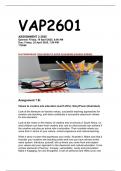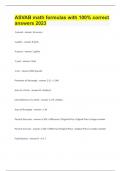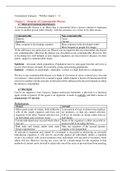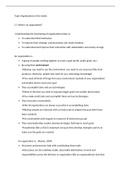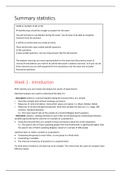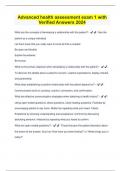Basic principles of colour perception
Most light we see reflected light. Some wavelengths = absorbed by surface they hit. The more
absorbed, the darker the surface looks. Other wl are reflected and part of these reflected wl reaches the
eyes. C of a surface depends on the mix of wl that reach the eye from the surface (+ from other surfaces
& lights present in the scene). Big mistake to think of specific wl s of light as being specific colours.
Colour = result of interaction of a physical stim w/ a particular NS.
Three steps to colour perception
1. Detection: wls must be detected
2. Discrimination: we must be able to tell the difference btw one wl and another
3. Appearance: we want to assign perceived colours to lights & surfaces in the world + we want
those perceived colours to go w/ the object and not to change as the viewing conditions change
(sun/shadow)
Step 1: colour detection
3 types of cone photoreceptors (they differ into the photopigment they carry; thus they differ in their
sensitivity to light of different wls). Types of cones named after their peak of sensitivity on the
spectrum: S (blue), M (green) and L (red). Their spectral sensitivities overlap. Cones daylight
(photopic); one type of rod photoreceptor dimmer light (scotopic).
Spectral sensitivity = sensitivity of a cell or a device to difference wl s on the electromagnetic spectrum.
Photopic = light intensities that are bright enough to stimulate cone receptors & bright enough to
“saturate” rod receptors (= drive them to their maximum responses).
Scotopic = light intensities that are bright enough to stimulate rod receptors but too dim to stimulate
cone receptors.
Step 2: colour discrimination
The principle of univariance
How do we distinguish wls in the visible spectrum? Different wls different experiences of colour.
Varying responses of photoreceptors to different wl s (they have specificities regarding wl s) basis for
colour vision.
However, output of a single pr = ambiguous principle of univariance.
Principle of univariance = fact that an infinite set of different wavelength-intensity combinations can
elicit exactly the same response from a single type of pr. One pr type cannot make colour
discriminations based on wavelength.
Univariance explains the lack of colour in dimly lit scenes. One single type of rods: all have the
photopigment rhodopsin they all have the sale sensitivity to wavelength scotopic conditions:
possible to tell light from dark but impossible to discriminate colours because of univariance.
The trichromatic solution
Any wl in the visible spectrum produces a unique set of 3 responses from the three types of cones. Here,
the univariance problem doesn’t apply (change the intensity: the values will change but not
proportionality: if you had a response for L which was twice as strong as the M’s one, both the
responses will rise but the relationship “twice” will still be the same). Those relationships define our
, response to light & the colour we see. You can associate one number to each of the three responses
trichromatic theory of colour vision (= trichromacy).
Trichromacy = theory that the colour of any light = defined in our visual system by the relationships of
three numbers (the outputs of 3 receptor types (= 3 cones).
Metamers
We always talk about “wavelengths or mixtures of wavelengths” we are not exposed to single
wavelengths. Lights & surfaces we see emitting or reflecting a range of wavelengths. How do our
cones respond to combinations of wls of lights?
If a combination of wls results in yellow for example and looks exactly the same as a single yellow
wavelength metamers.
Metamers = different mixtures of wavelengths that look identical. More generally, any pair of stimuli
that are perceived as identical in spite of physical differences.
Caution:
- Mixing wls does not change the physical wls. Mix 500 and 600: it contains 500 and 600, not the
average of 550. Colour mixture = mental event, not a change in the physics of light.
- For a mixture of red a green to look perfectly yellow need to have the right red & green.
Other mixes will look reddish or greenish.
All the light reaching the retina from one patch in the visual field converted into 3 numbers by the 3
cone types. Numbers are sufficiently different from numbers in another patch able to discriminate
these patches. colours. If not, patches = metamers. They will look identical, even if the wl s = physically
different;
A brief digression into lights, filters and finger paints
Additive colour mixture = mixture of lights. If light A & light B = both reflected from a surface to the eye
effects of those two lights add together.
Subtractive colour mixture = mixture of pigments. If pigments A & B mix some light shining on the
surface = subtracted by A, and some by B. Only the remainder contributes to the perception of colour.
An additive mixture of lights that look blue and yellow (yellow = red + green) will look white if you have
exactly the right blue & yellow because that combination produces a mix of wavelengths that stimulate
the three cones equally.
From retina to brain: repackaging the information
Tell the difference between different lights (neural basis) nervous system looks at differences in the
activities of the 3 cone types (this work being sin the retina) computing differences btwn cone
responses. Because L and M are so similar, a single comparison btwn S and (L + M) provides almost same
info that would be found in (L – S) & (M – S) signals. Combining L & M signals = good measure of
intensity of light (S-cones = small contribution to perception of brightness).
Finally, three new signals: (L – M), ([L + M] – S) & (L + M).
Cone-opponent cells in the retina and LGN
LGN = Lateral Geniculate Nucleus. Structure in the thalamus, in the midbrain, that receives input from
the retinal ganglion cells & has input & output connections to the visual cortex.
Centre-surrounds characteristics of ganglion cells in the retina & the LGN similar antagonistic
relationship characterizes colour. Some of these retinal & LGN ganglion cells = excited by L-cone onset
int heir centre & inhibited by M-cone onsets in their surround. These (L – M) cells = one type of cone-
opponent cell. Cone-opponent cell = cell type (retina, LGN & visual cortex) that subtracts one type of
cone input from another.


